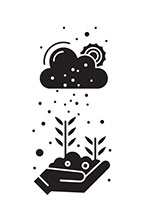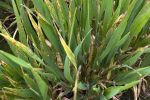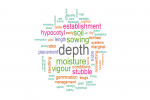Key points
- Faced with a late summer sowing opportunity, northern growers must weigh up the benefits of planting versus fallowing
- CSIRO senior principal research scientist Dr Lindsay Bell and the Northern Farming Systems team have compared options and their consequences
- Planting a late summer crop and being flexible with planting dates can often pay off
Growers in the northern region are often faced with a challenging decision – what to do with a late summer sowing opportunity, says CSIRO farming system specialist Dr Lindsay Bell.
The key considerations are:
- should a late summer crop be sown; or
- should the system be kept in fallow ready for an autumn sowing opportunity?
“Essentially, the question is – is this a good decision to make now no matter what the future holds?” Dr Bell says. A decision on a late sowing opportunity can be challenging for two reasons. This late summer sowing window does not have many ‘conventional’ crop options to suit. Less widely grown crops need to be considered. Additionally, there is a fear that using this crop opportunity will impinge on future crop choices or options.
Planting on late summer breaks (after mid-January) requires the following options to be weighed up.
1 Remain in fallow
If the soil profile is already fairly full – greater than 60 per cent – there are potentially two risks with this choice:
- any further rainfall might be wasted – through run-off or evaporation – and not used productively; and
- a sowing opportunity for the following winter crops may not occur in a suitable window to optimise stored soil water.
2 Plant sorghum
With a late sowing date, ripening will occur after late March. Potentially cooler conditions increase fungal disease risks, and if it is difficult to dry down the crop, there could be significant downgrades or yield losses.
3 Plant mungbeans
This is the preferred fallback option. As a shorter-season crop, mungbeans can still allow for a double crop. That is, straight back into a winter crop under a wet autumn or early winter. Other options include maize, sunflowers, millet and forage crops.
What does the research say?
For the past 10 years, the GRDC-supported Northern Farming Systems project team has compared some of these options and followed the impacts across subsequent seasons.
Dr Bell walks through three case studies to illustrate how different decisions on later summer crops developed.
Case study 1: Summer 2019-20
Crop decision triggered
With less than 50 millimetres of rain, 2019 was a very dry winter. However, in late January, the trial site received 125mm of rain. Dr Bell says this rainfall was just enough to meet the project’s planting trigger for some farming systems – 90mm of plant-available water. Crops were sown to French white millet and mungbeans on 22 January 2020, while other sites remained in fallow.
Crop performance and outcome
In-crop rain from sowing until the end of May was well below average at 165mm and crop yields were lower than expected. “These crops barely broke even,” he says.
“This then had a negative impact on soil water at sowing and subsequent sorghum crop yields. Over this two-year period, this opportunity returned about $150 to $200 less a hectare than maintaining a fallow.”
Table 1: Case study 1 results.
Crop yield | Subsequent | Total gross margin generated | |
Fallow | – | 4.42 | 830 |
Mungbeans | 0.51 | 3.44 | 690 |
Millett | 0.40 | 2.53 | 630 |
Source: Dr Lindsay Bell, CSIRO
Case study 2: Summer 2020-21
Crop decision triggered
Reasonable soil water had accumulated over winter and spring and, with an extra 50mm in early January, soil water was greater than 150mm – sufficient for several crop options to be considered. Maize and mungbeans were sown on 14 January, while other sites remained fallow.
Crop performance and outcome
In-crop rain received was 350mm and both crops achieved satisfactory yields. Due to the favourable 2021 season, wheat was sown following both the mungbeans and the fallow system (a late maize harvest prevented a subsequent winter crop). All systems were sown again to sorghum after the wheat harvest. Where later summer crops had been sown, an advantage of $1000/ha in gross margin across the two-year period occurred.
Table 2: Case study 2 results.
| Subsequent crop yields t/ha | ||||
| Crop yield (t/ha) | Wheat 2021 | Sorghum 2022 | Total gross margin generated over two years ($/ha) | |
| Fallow | – | 4.05 | 4.00 | 1750 |
| Maize | 6.10 | – | 5.82 | 2680 |
| Mungbeans | 1.13 | 4.11 | 4.46 | 2750 |
Source: Dr Lindsay Bell, CSIRO
Case study 3: Summer 2023-24
Crop decision triggered
Following 2023’s particularly dry spring, there was limited soil moisture until significant rain in late December and early January. The soil profile was greater than 170mm of plant-available water, prompting a sowing opportunity. Maize, mungbeans and sunflowers were planted on 25 January, while some systems were left fallow.
Crop performance and outcome
In-crop rain of 350mm fell from sowing until the end of May. The late-sown summer crops achieved good yields and were highly profitable. However, the late harvest of maize and sunflowers meant that these systems could not be sown to a winter crop.
By comparison, the fallow systems had accumulated a full profile and were sown to wheat on 30 April. With sufficient residual moisture following mungbeans, barley was sown on 24 May.
Where summer crops were sown in this 18-month period, the accumulated gross margin was more than $1000/ha higher than those that remained fallow.
Table 3: Case study 3 results.
| System | Crop yield (t/ha) | Wheat yield (t/ha) | Estimated gross margin ($/ha) |
| Fallow | – | 4.15 | 890 |
| Maize | 7.18 | – | 1770 |
| Sunflowers | 3.12 | – | 2200 |
| Mungbeans | 1.36 | 4.85 | 2100 |
Source: Dr Lindsday Bell, CSIRO
To plant or not?
Dr Bell says these case studies show there are often few regrets in making use of a late-January sowing window provided:

- sufficient soil water has accumulated to reduce the risk of water stress in the crop if in-crop rain is inadequate; and
- growers are comfortable with alternative crops sown within an appropriate window. Dr Bell says several crop options can suit this niche sowing time, such as mungbeans, maize or sunflowers.
“While the next crop may be missed or a yield penalty induced, this is often more than made up for by the returns from the previous summer crop.
“The upside if subsequent conditions are favourable often far exceeds the downside when conditions are more challenging.”
Dr Bell says it is also worth thinking about the risk of not taking the opportunity. “There is not always surety that a good sowing opportunity will present itself for a winter crop.
“For example, long-term climate information at Pittsworth on the eastern Darling Downs shows that only in 50 per cent of years does greater than 20mm of rain occur over a three-day period in early winter. So, there is always a risk that there will not be enough rain to trigger a winter plant,” Dr Bell says.
“Having a farming system that has the flexibility to use sowing opportunities throughout the year, rather than just limiting sowing to particular sowing windows, can create significantly higher returns over time. This more efficiently converts rainfall into grain and economic returns.”

























































